We are reader supported. When you purchase through links on our site, we may earn an affiliate commission. Also, as an Amazon affiliate, we earn from qualifying purchases.
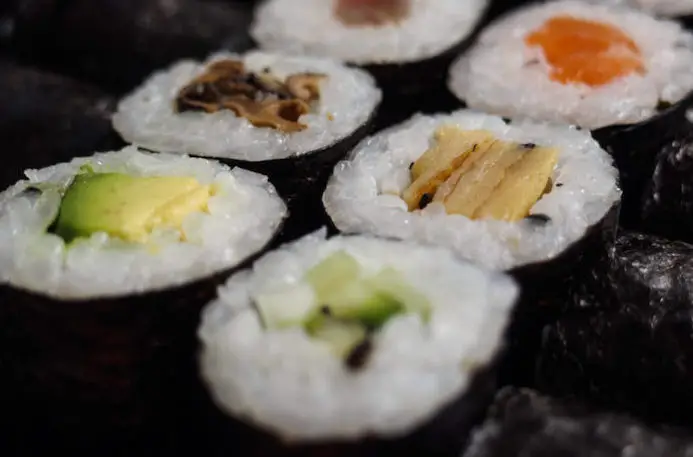
Maki sushi or Maki zushi (pronounced as mah-kee-zoo-shee) as it is called in Japanese, is one of my favorites when it comes to oriental cuisine. I did some research on how it got its name and found two interesting concepts that I would like to share with you.
First, maki sushi derives its name from ‘maku’ which means to roll/ wrap for the obvious reason of rolling ingredients in seaweed or nori. Another source says maki sushi derived its name from the bamboo mat (known as makisu in Japanese) that is used to roll sushi.
In any case, whether the name of the sushi emerged from ‘maku’ or ‘makisu’, it has something to do with rolling which forms the foundation of this delicacy. While the names of different types of sushi may vary depending on the ingredients, if it has maki in its name, it is rolled.
Contents
What Does A Maki Sushi Typically Comprise Of
The traditional maki sushi comprises of seaweed or nori on the outside, vinegared sushi rice inside with one, two, or more fillings which may be raw fish, cooked meat or vegetables. As nori is one of the essential ingredients that give it that dark green personality, it is often called as norimaki in Japan.
Depending upon the choice of filling, there can different types of maki rolls such as avocado roll, salmon roll, tuna roll, eel roll, cucumber roll, and so on. Besides the nori and fillings, sushi rice is also an important ingredient, which is the binding factor for the entire dish.
If you want to try
What Skills Do You Need For Maki Rolls
The Japanese take their food and culture very seriously and a sushi chef often undergoes years of intensive training to master the skills and techniques for making the perfect maki rolls. Some intricacies go into the process such as spreading the rice correctly, arranging ingredients, rolling like a pro, and cutting precisely.
The maki sushi has become so popular today that you can find this variety at any sushi restaurant outside Japan. You can also find them in the grocery stores, convenience stores, and supermarkets. Good news is that you can even make them at home.
Although maki sushi looks like it is difficult to master, it is one of the easiest and simplest forms of sushi. If you wish to try it at home, you will need a few essential items as mentioned below. Even though it doesn’t come out perfectly first time, don’t worry because it will taste incredible anyway!
Bamboo Mat
A good quality bamboo mat like this on Amazon is made from thin pieces of bamboo with strings holding them together. Susi chefs swear by them and it is an essential item for beginners. It provides a working place to put all ingredients together and form a compact roll.
Short grain Japanese rice
To make perfect maki rolls, you need to start with buying the right type of rice. Short grain Japanese rice is sticker than other variations and works perfectly for this delicacy. You can find short grain Japanese rice at any Asian grocery store or buy it online (click to see my favorite brand).
Sushi fillings/ ingredients
As mentioned above, the sushi fillings can vary widely depending upon availability and preference. The most common and popular ingredients are raw salmon, raw tuna, simmered shiitake, rolled omelet, sakura
The ingredients are carefully selected by the sushi chef to ensure that the colors, taste, and texture complement each other. While we mostly use dark green Nori sheet in making sushi, it may sometimes be wrapped in soy paper, cucumber, and even egg.
5 Different Types Of Maki Sushi You Can Try At Home
When I was a beginner like many of you, I too believed that all maki sushi were alike. It was only when I expanded my knowledge on the subject and became a true maki sushi fan, I discovered the different types and varieties that are possible.
Interestingly, the different types of maki sushi are based on a few variables such as the ratio/ proportion of rice and ingredients, how far to spread the rice, how thick the layer of rice should be, where to put the fillings, how to roll, and finally, how many pieces to cut the roll into.
Based on these variables, there are 5 different types of maki sushi that you may try making at home. Let me take you through each of them, their unique features, and requirements.
#1. Hosomaki Rolls
Hosomaki rolls are gaining immense popularity worldwide because they make a simple and light snack that can be eaten in a single bite. These rolls usually contain sushi rice inside and nori on the outside with just one filling, which may be raw fish or vegetable.
They are slim rolls (about 1 inch in diameter) with a thin layer of sushi rice. However, the delight lies in its simplicity as eaters get to savor one flavor to the fullest. As it contains only one ingredient, here are a few types of Hosomaki rolls based on the type of ingredient used.
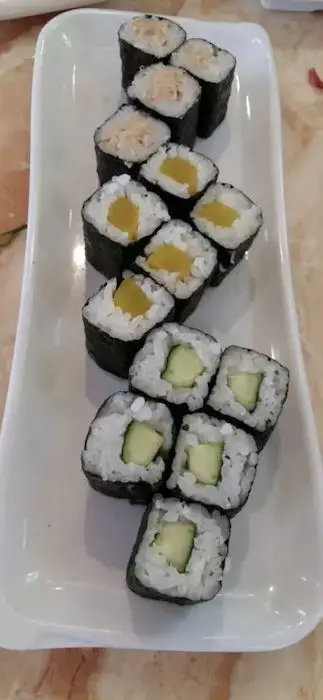
• Tekkamaki: They mostly use raw tuna fish inside and this form originated in the gambling dens, where they were known as ‘tekkaba’. It was considered as a quick snack that can be eaten by just one hand.
• Kappamaki : This type of roll has strips of Japanese cucumber inside, and it is traditionally used as a palate cleanser between different types of sushi containing fish or seafood.
• Negitoromaki: The roll usually has chopped fatty tuna inside; along with some pieces of chopped scallions or negi.
• Kanpyomaki: For this type of roll, dried gourd strips or kanpyo are marinated to use as ingredients
• Takuan Hosomaki: This is style of roll contains takuan or pickled daikon as the one and main ingredient.
How to make hosomaki rolls
You will need:
• Seasoned sushi rice
• Nori
• Filling (Raw fish, seafood, cucumber, or avocado)
• Soy sauce, pickled ginger, and wasabi
You can have a look some of my recommended ingredient brand here
Instructions
Moisten your hands before you start to prevent the rice from sticking on your hands. Gather all ingredients together.

Take a half sheet of Nori (resembling a rectangle) and put it on the bamboo mat, spread a thin layer of sushi rice on it, leaving about one inch on the sides that will be used to seal the roll.
Use your fingers to apply gentle pressure to make the sushi rice flatten out evenly without getting mashed. Don’t use a rice paddle to do this or you will end up pasting the rice.
Apply a strip of wasabi or some other condiment of your choice across the center of the rice to enhance the taste.
Now, place the desired filling, raw fish, fruit, or vegetable on a row over the sushi rice across at the center of the nori.
Lift the bamboo mat and start rolling with the help of your thumbs. Apply gentle pressure and gently squeeze on the ends to seal the roll. You may run a wet finger on the far end of Nori to seal well.
Now, moisten the sushi knife with a solution made by mixing water and vinegar. Cut 6-8 equal slices of the roll and serve with soy sauce, pickled ginger, and some wasabi.
#2. Chumaki Rolls
Chumaki is the slightly bigger sibling of Hosomaki and it is often referred to as the medium-sized roll. It may contain 2-3 ingredients and have a diameter of about 1 1/2″ when assembled. Many people find this size easiest to roll as they get a good grip and enough area to seal the roll.
Interestingly, the name ‘Chumaki’ is not as popularly used as hosomaki or futomaki on the Internet or restaurants around the world. Despite the fact that rolls containing 2 or 3 ingredients are made every minute at restaurants and homes across the world, very few people know it by this name.
Now that you know it, pass on the info to others and try making Chumaki at home using simple ingredients that you can find online or at any Asian grocery store.
How to make Chumaki rolls:
You will need:
• Sushi Rice
• Nori
• Minced green onions
• Strips of Japanese or English cucumber
• Cream cheese cut into strips
• Sushi-grade cold salmon
Instructions
Take one full-size Nori sheet and place it on the bamboo mat. Now, take about 1 cup of sushi rice (medium sized ball) and spread out the rice evenly on the nori.
Dab your fingers in vinegar water and press the rice gently to ensure that it evenly sticks to the Nori sheet Leave a 2 1/2″ gap along the farthest side of the Nori.
Spread some wasabi or any other condiment of your choice across the center. Place rows of cream cheese strips over the sushi rice across the midsection. Sprinkle the minced spring onions over it.
Now, place a row of sliced raw salmon across the entire width of the nori sheet. Put the cucumber strips just beside the cream cheese and salmon to add some freshness.
Lift the side of the bamboo mat close to you and start rolling to make a compact roll, pressing gently in between to ensure that all the ingredients stick together tightly.
When you are close to the end and nori is still visible, stop and give one tight hug with the bamboo mat. Seal the end with a few grains of sushi rice or you may run wet fingers on the bare surface and seal.
Moisten your knife and cut the Chumaki roll into 6-8 equal pieces. Serve with soy sauce, wasabi, and pickled ginger.
#3. Futomaki Rolls
While Hosomaki is the skinny elder brother, Futomaki is like the fat younger sibling, the type of maki sushi that is extremely popular in the western countries. While both the types have nori wrap on the outside and sushi rice layer inside, the biggest difference is the number of fillings used.
Futomaki rolls are plump and luscious, usually containing 4 or more fillings that complement one another. They are mostly larger than other varieties of sushi, about 2 to 2.5 inches in diameter. As a result, you cannot eat too many Futomaki rolls at once.
Although Futomaki is made and served all the year round in Japan, it is considered as the chief dish for Setsubun, the day when people pray for a good year filled with happiness. During this period in Japan, the futomaki rolls are known as ‘Ehomaki’ or ‘Eho’ referring to the lucky direction.
The best thing about futomaki is that you can use leftover trimmings or various meats as ingredients in the roll because the quality is not affected by it. Many sushi chefs use leftover trimmings in futomaki to cut down on costs and waste.
How to make Futomaki rolls:
You will need:
• Vinegared sushi rice
•
• Seasoned shitake mushrooms
• Imitation crab cut into long sticks
• Spinach
• Cucumber julienne cut into strips
• Tamago (egg omelet)Imitation crab cut into long sticks
• Spinach
• Cucumber julienne cut into strips
• Tamago (egg omelet)
To make Kanypo you will need: 1 ounce dried daikon radish, water for soaking, 2/3 cup dashi soup stock, 3 tbs soy sauce, 2 tbs sugar, and 1 tbsp mirin.
Instructions: Wash dried kanypo, drain and soak in fresh water for one hour until it gets soft. Squeeze out excess water and cut into 8-inch long strips. In a pot, mix soy sauce, dashi soup stock, sugar, and mirin. Bring to boil and then simmer on low heat until liquid evaporates.
To make Tamagoyaki (egg omelet) you will need: 2 eggs, canola oil, and 2 tsp sugar.
Instructions: Beat the eggs and sugar in a bowl. Heat oil in a small pan and coat the entire surface. Add the egg mixture to create a thin layer and fold slowly to create a thickly rolled omelet. Let cool it and then cut into long sticks.
To prepare spinach: Take 3 cups of water and half a tsp salt and bring to boil. Now, add spinach to the pot and let them cook for 1-2 minutes. Allow the spinach to wilt but don’t let them get too mushy. Drain and rinse with cold water.
To make seasoned shitake mushrooms you will need 6 dried shitake mushroom, 1/4 cup of shitake water, 1/4 cup of homemade dashi, 2 tbs of mirin, 1.5 tbsps soya sauce and 1.5 tbs sugar.
Instructions: soak the dried mushrooms in one cup of water overnight, squeeze out soaked mushrooms and keep the shitake juice aside. Remove stems and slice the mushrooms into thin slices. Put inside a pot and add the shitake juice, sugar, dashi, and mirin. Bring to boil, reduce to simmer and cook for 10 minutes. When it turns soft, add soy sauce and cook for another 2-3 minutes.
Now, let’s get rolling:
Place the bamboo mat on the working surface and put a full-size Nori sheet on it.
Moisten your hands, take 1 and a half cup of seasoned sushi rice and spread it out evenly on nori
Use your fingers to press the rice. Remember to leave out about one-inch gap on the farthest side away from you
Place two rows of seasoned shitake mushrooms at the center of the rice. Spread a row of spinach next to shitake, away from you. Place some cucumber strips in a row next to spinach.
Add tamagoyaki and Imitation crab strips on the side closer to you and next to shitake mushrooms.
Now lift the bamboo mat from your side and start rolling and keep pressing as you do to make a compact roll. Stop where the mat touches the ending line of the rice and tug it closer 3 times to ensure the fillings hold on tightly.
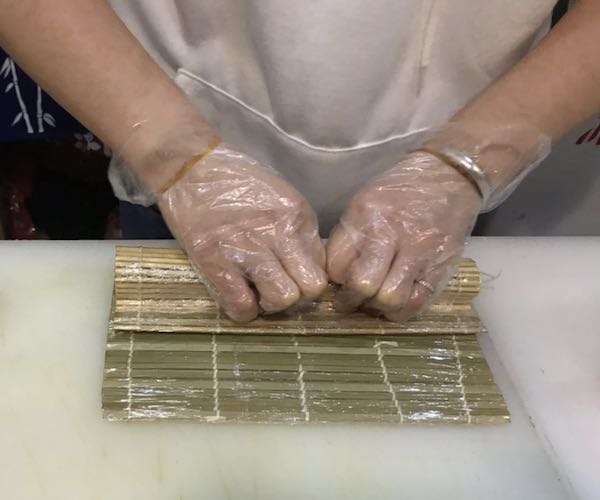
Seal the edges by running wet fingers on the gap we left on nori earlier. Once sealed into a tight and compact roll, moisten a sharp Japanese knife like this and cut the roll into 6-8 equal pieces. Serve with ginger, soy sauce, and wasabi.
A pro tip – Cut the fillings into long sticks for even distribution and easier rolling. Place large items on the bottom end and smaller ones on the top. As futomaki is a big roll, spread out the fillings to accommodate the size of the roll.
#4. Uramaki Rolls
If you have eaten sushi before, you must have crossed paths with this popular style of inside-out roll, which is largely popular among the people in the US. In the western countries, it is popular as the California roll (click to see recipe) but the traditionalists in Japan don’t seem too enthusiastic about uramaki.
Uramaki may have two or more fillings inside, just like Chumaki but the only difference is that it is rolled inside out to have sushi rice on the exterior side. The origin of this type of maki dates back to the late 1960s when Machita Ichiro started the Little Tokyo restaurant in Los Angeles.
Unable to find sushi-grade fat belly tuna to make maki, the chef started using avocado instead as the fruit has a similar consistency similar to toro. The Japanese customers liked the change and avocados became a popular substitute ingredient.
When the number of American customers visiting the restaurant grew, many did not like the appearance and taste of seaweed. So, the chef devised a way to turn the roll inside out to have rice outside and nori inside, in a way of hiding it.
Related Article: Easy Natto Maki Recipe (Japanese Fermented Soybeans)
How Is Uramaki Different From Traditional Maki Rolls
Although this style of maki gained immense popularity in the US, it is not widely duplicated in Japan. The Japanese like the crunchy taste of nori on the outside. Furthermore, uramaki tends to fall apart easily when picked using chopsticks and dipped in soy sauce.
Uramaki has sushi rice on the outside, so you don’t need to consume it immediately. As the nori sheet is hidden inside the roll, there is no fear of it splitting. The maki roll that has nori on the outside splits soon because the rice expands after some time.
While most of the other styles of traditional maki have their roots in Japan, Uramaki was developed in the US keeping the American diners in mind. It is not as popular in Japan.
How to make Uramaki rolls
You will need:
• Vinegared sushi rice
• Nori sheets
• Imitation crab cut into long sticks
• Avocado, peeled, pitted and cut into slices (sprinkle some salt to prevent browning)
• Cucumber, de-
• Roasted sesame seeds
Instructions
Put the bamboo mat on the table and cover it with a plastic sheet this time so that sushi rice does not stick to it when you flip the nori sheet.
Put the nori sheet on the bamboo mat and spread out a medium ball of sushi rice on top of the nori. Moisten your hands and press gently to get an even layer.
Sprinkle some roasted sesame seeds generously over the sushi rice and flip over the nori sheet to have rice layer at the bottom and nori on top.
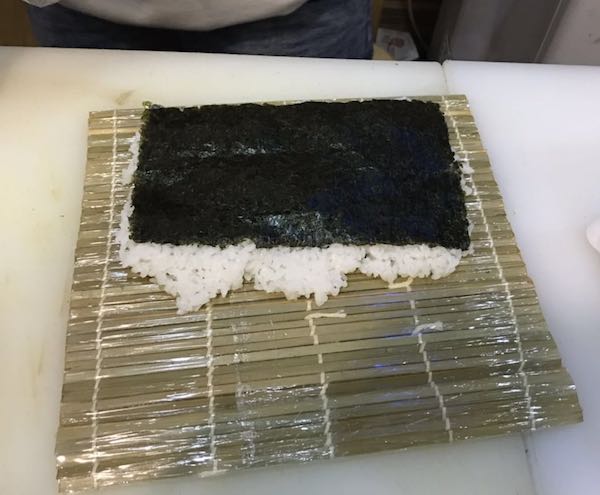
Now, arrange the ingredients on top of sushi rice towards the center. First the crab sticks in a row, then avocado and cucumber. You may substitute with any other fillings of your choice.
Now, lift the bamboo mat using your fingers and press gently to ensure that the fillings stay in place. Start rolling just as you do for other rolls to get a compact shape.
Wipe the blade of your sharp Japanese knife using a moist cloth and cut the uramaki roll into 6-8 pieces with the plastic wrap attached. Now remove the plastic and serve with soy sauce, wasabi, and pickled ginger.
#5. Temaki Roll
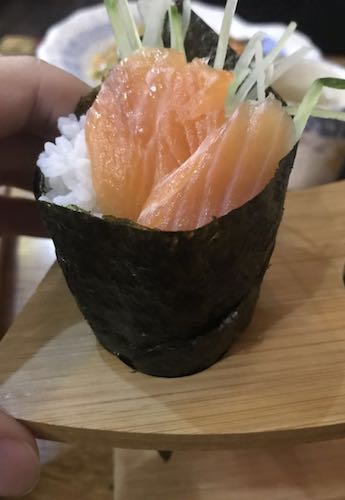
‘Te’ refers to hand, and this style of maki is called temaki because unlike other rolls, you use hands instead of a bamboo mat to roll. It comprises of nori, sushi rice, and toppings. While other maki rolls are shaped like a cylinder, this one is shaped like a cone and it is eaten with hands instead of chopsticks.
The ingredients used in Temaki are already dipped in soy sauce you don’t need to dip again. You can eat it straight away like an ice-cream. As nori tends to lose crispiness as it absorbs moisture from sushi rice and fillings inside, the maki tastes best when eaten immediately
Also known as Japanese hand rolls, temaki is the more casual and fun version of the popular delicacy. It has a fun appearance with ingredients popping out of the cone. Hence, this is a great choice for sushi parties.
Related Article: Proper Way to Eat a Hand Roll [Temaki]
How to make Temaki sushi
You will need:
• Seasoned sushi rice
• Sashimi grade tuna Tuna minced into 1/4 inch cubes
• Japanese or regular mayonnaise – 1-2tbs
• Finely minced green onions- 2tbs
• Sriracha Hot Chili Sauce- 2tbs
• Hot sesame oil (
In a small bowl, mix mayonnaise, green onions, chili sauce, and hot sesame oil. Add the minced tuna to sauce, cover and let it sit inside the fridge until you are ready to use.
Take a full-size Nori and cut it into a half. If you wish to make mini rolls, you may further reduce the size to one-fourth of the sheet.
You need to retoast the nori to ensure that they become crispier than before. Just put the gas stove or electric heater on the lowest flame and pass the Nori sheet back and forth from a distance for 5-10 seconds.
Spread the seasoned sushi rice on one end of the Nori, covering at least one-third of the area. Use no more than ¼ cup of sushi rice.
Load up the sushi rice with the fillings prepared above. Arrange the fillings diagonally across the sushi rice.
Now start folding from one corner of the nori sheet to form a cone shape. You don’t have to worry about the cone falling apart because the nori absorbs moisture form sushi rice and sticks.
Seal the edges with a few grains to ensure that the cone stays in shape. In some places, they may wrap the cone in the plastic sheet until you are ready to eat it.
Insider Tips And Secrets To Help You Make Good Maki Rolls
• Even when you are making ‘inside rolls’, make it a point to cover the bamboo mat with a plastic cling film(see blewo) to prevent the rice from accidentally sticking on the mat. This will save you from washing the mat frequently.
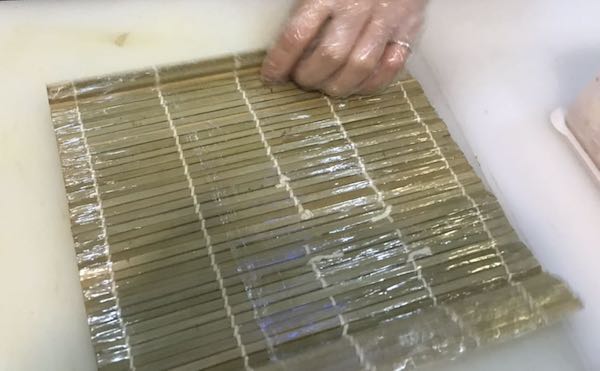
• Keep a bowl of water and vinegar mix next to you. Mix one part of vinegar with one equal part of water to make the cleaning solution. Dip your fingers and knife in this solution to ensure that rice does not stick on.
• When preparing maki, always remember to keep the shiny side of the nori down to get a good glaze on the outside. Always choose a good quality nori brand that will stay crispy for long.
• When making futomaki, make sure you have all the fillings and other ingredients prepared and ready to use on the table before you start rolling.
• Prepare sushi rice at least 30 minutes before you intend to eat sushi. Too hot rice will turn the nori soggy while too cold may not be able to stick together with fillings. It should ideally be at room temperature.
• After you are done rolling, trim the ends to ensure that you have clean and good looking sushi pieces on the plate.
Common Mistakes To Avoid When Preparing Maki At Home
• Using a dull knife to cut maki rolls can be hazardous as you may end up injuring yourself. Always use a sharp Japanese sushi knife meant for cutting rolls.
• Too many ingredients in the maki may make it difficult to roll and the dish may fall apart. Use fillings that complement each other.
• Overdoing with the sauces can kill the effect, as the roll will get too wet to enjoy. You may dip the pieces in the sauce later just before consuming them.
• Using too much sushi rice on the roll (unless you are doing a futomaki) can make it difficult to roll and overpower the taste.
Related Questions
Can sushi rolls be made without rice?
While sushi rice forms an essential ingredient for maki rolls, some fitness enthusiasts have come up with Keto low carb sushi rolls. Others like to substitute rice with quinoa, cauliflower, etc.
How many pieces do you usually cut the maki rolls into?
Maki is also known as cut rolled sushi that is usually cut into 6-8 equal pieces. The futomaki is often cut into 4 pieces only because making too many cuts may cause the excess fillings to fall apart.
How to make maki sushi without a mat
If you don’t have a bamboo mat, you may use a kitchen towel or plastic sheet to roll your sushi. However, I highly recommend getting a bamboo mat to give a professional finish to your rolls.
What substitutes can I use for nori
If you don’t have nori sheets available or you don’t like the taste of nori sheets, you may consider using soy paper, cucumber cover or cauliflower leaves to wrap maki rolls.
What is Ehomaki roll?
This is a kind of futomaki roll but this one comprises of seven different ingredients and is considered as auspicious when eaten on setsubun in Japan. People eat ehomaki facing the direction that is believed to be lucky that year. Some of the common choices of ingredients include egg, kanpyo, eel, shitake mushrooms, spinach, and so on.
What drink goes best with maki sushi
While the westerners like to pair up sake with maki sushi rolls, the Japanese traditionalists don’t approve of it. Despite that, you can now find sake served in several sushi restaurants in Japan. Other popular drinks that go well with maki rolls are Japanese beer, green tea, and white wine (red wines are good too!) Read this article for more information on pairing sushi with drinks.
Can you freeze maki sushi?
You may freeze
What is the difference between sushi and maki?
All types of maki rolls are sushi, but all types of sushi are not maki. Sushi is anything that comprises of sushi rice and fillings like raw fish or vegetables. Maki, on the other hand, is sushi rolled in seaweed, hence it is also often known as norimaki.
How much calories in a maki roll?
Typically, one piece of maki roll has about 45 calories. So, an order of 6 maki pieces can give you 250 to 375 calories, depending on the type of fish and vegetables used.

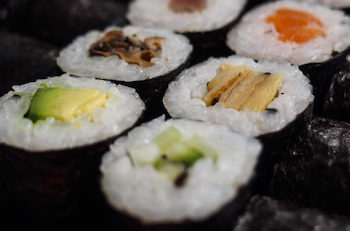
Comments
Pingback: What is the Difference Between Kombu and Nori? - Easy Homemade Sushi
Pingback: Why is Sushi so Popular? - Easy Homemade Sushi
Pingback: What is the best Nori for Sushi? - Easy Homemade Sushi
Pingback: Proper Way to Eat a Hand Roll [Temaki] - Easy Homemade Sushi